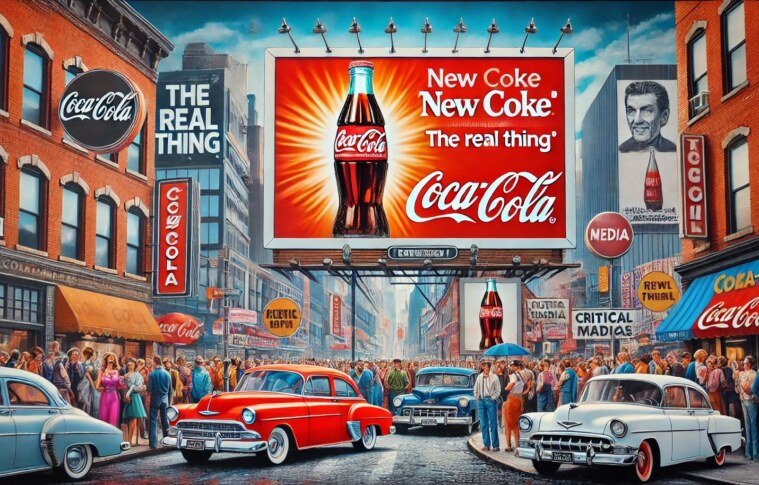Coca-Cola’s 1985 launch of “New Coke” stands as one of the most infamous product missteps in business history. Despite rigorous planning and research, the initiative sparked a backlash that forced the company into a rapid and public reversal. The episode is a masterclass in understanding customer loyalty, emotional branding, and market perception, illustrating the dangers of prioritizing product changes over the intangible values a brand represents.
Background and Context
Founded in 1886, Coca-Cola had become an emblem of American culture by the mid-20th century. By the 1980s, however, the brand faced a growing challenge from PepsiCo. Through its “Pepsi Challenge” marketing campaign, Pepsi had been eroding Coca-Cola’s market dominance, positioning itself as the youthful and modern alternative. Pepsi’s sweeter taste profile was especially popular among younger consumers, threatening Coca-Cola’s market share.
In response, Coca-Cola decided to overhaul its flagship product—a bold move aimed at reclaiming its competitive edge. The decision was not made lightly; it was the result of extensive market research and taste tests that suggested a new formula would outperform both Pepsi and the original Coke. With the confidence of these findings, Coca-Cola introduced “New Coke” in April 1985.
The Decision to Change the Formula
The rationale behind the formula change was rooted in competition and innovation. Internal analyses revealed that Coca-Cola’s taste was perceived as less sweet and less favorable compared to Pepsi in blind taste tests. Executives feared that clinging to the original formula might result in the brand becoming outdated.
To mitigate risk, Coca-Cola conducted one of the largest consumer research initiatives in its history. Over 200,000 people participated in taste tests, with the majority preferring the new formulation. Encouraged by this data, the company concluded that the new formula was the logical next step to maintain market leadership.
The Launch of New Coke
On April 23, 1985, Coca-Cola officially unveiled New Coke. The marketing campaign surrounding the launch emphasized modernity, better taste, and a bold step forward. Coca-Cola executives were optimistic that the move would reignite consumer enthusiasm and reinforce the brand’s position against Pepsi.
The initial rollout appeared promising, with some younger consumers appreciating the sweeter taste. However, within weeks, cracks began to appear in the strategy. Many loyal Coca-Cola drinkers expressed outrage, lamenting the loss of the original formula. This unexpected backlash highlighted a crucial oversight in the company’s research: the emotional attachment consumers had to the original Coca-Cola.
Consumer Backlash
The intensity of the negative response surprised Coca-Cola. Protesters organized campaigns to demand the return of the original formula, and some even hoarded the remaining inventory of “old” Coke. Phone calls, letters, and petitions flooded Coca-Cola’s headquarters. Many customers viewed the change as an affront to tradition and identity.
One of the most notable responses came from the southern United States, where Coca-Cola had a particularly strong cultural significance. In these regions, the backlash was less about taste and more about the perceived betrayal of a cultural icon.
Media coverage amplified the controversy, framing the situation as a David-and-Goliath struggle between the corporation and its loyal customers. Late-night talk show hosts and newspapers mocked the company’s decision, turning it into a national conversation.
The Company’s Response
Faced with overwhelming criticism, Coca-Cola’s leadership had to act quickly. Just 79 days after the launch of New Coke, the company announced the return of the original formula under the name “Coca-Cola Classic.” This decision was framed as a response to consumer demand, with the company acknowledging its mistake in underestimating the emotional bond between the brand and its customers.
Coca-Cola Classic was reintroduced to enthusiastic acclaim, with customers rejoicing at the return of their beloved beverage. The speed and decisiveness of the pivot demonstrated Coca-Cola’s ability to listen to its customers and correct its course, an act that eventually turned the debacle into a success story.
Key Takeaways for Product Managers
The New Coke episode offers several lessons for product managers and leaders in any industry:
1. Balancing Data with Intuition
Coca-Cola’s decision was driven by data from taste tests, but the data failed to capture the emotional and cultural dimensions of consumer behavior. While data is invaluable, it must be contextualized with qualitative insights about customer values and perceptions.
2. The Importance of Brand Identity
Coca-Cola underestimated the symbolic weight of its brand. For many customers, Coca-Cola was more than a beverage—it was a symbol of tradition, nostalgia, and American identity. Any significant change to such a brand requires careful consideration of these intangible factors.
3. Real-World Testing is Essential
Taste tests in controlled environments cannot fully replicate the complexity of real-world consumer behavior. Coca-Cola’s testing failed to account for how customers would feel about the change once it was tied to the brand and its history.
4. Agility in Crisis Management
Coca-Cola’s swift pivot to reintroduce the original formula was a masterclass in crisis management. The company acknowledged its mistake, responded to feedback, and took corrective action quickly. This agility helped salvage customer trust and reinforced the company’s image as responsive and customer-focused.
5. Perception is as Critical as Product
New Coke may have been objectively better in taste, but perception is reality in marketing. Coca-Cola’s failure to manage the narrative around the change allowed negative sentiments to dominate public opinion.
Broader Implications
The New Coke incident transcends its immediate context to offer lessons for businesses grappling with innovation and change. The episode underscores the complexity of balancing customer feedback with bold product decisions. While companies must innovate to stay relevant, they must also ensure that their changes align with the core values and expectations of their customer base.
In modern contexts, the rise of social media has amplified the risks associated with such changes. Brands today must be even more vigilant in monitoring public sentiment and addressing concerns in real-time.
The Legacy of the New Coke Incident
Ironically, the controversy surrounding New Coke ultimately benefited Coca-Cola in the long run. The reintroduction of Coca-Cola Classic rejuvenated customer loyalty, with sales of the original formula surging. The company used the experience to reinforce its brand identity, emphasizing its commitment to tradition and customer satisfaction.
Coca-Cola continued to innovate, but with greater sensitivity to customer perceptions. The episode also entered the annals of business history as a case study in the importance of understanding emotional branding and market perception.
Conclusion
Coca-Cola’s “New Coke” episode is a powerful reminder that a product is more than the sum of its features. It represents the values, emotions, and identities of its customers. By overlooking these factors, even the most well-intentioned innovations can backfire. For product managers and business leaders, the case is an enduring lesson in the art and science of balancing innovation with customer loyalty, and in the power of perception in shaping market outcomes.



